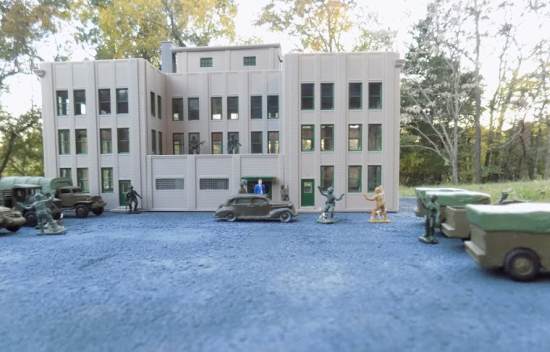Battles in Axis & Allies are decided by tank duels.
Armored Fist
Since infantry are virtually defenseless against armored vehicles, the outcome is usually determined as soon as one tank force is eliminated. It is unlikely that infantry will score a hit against a tank unless it is exposed or severely damaged.

The heavy tanks - KV-1, Churchill Crocodile, and Tiger - are almost unstoppable because their superior armor makes it difficult to score a critical hit. Unless their defense is overcome by two or more extra attacks, they will not be damaged, and disruption only lasts one turn. Even at point-blank range, most close-assault tactics or field guns are unable to score "9" successes (the number required to damage most heavy tanks).
Balance of Power
Many armored units have special characteristics that can be helpful or harmful. For instance, the Italian medium M13 tanks are highly flammable and will probably be destroyed as soon as they take damage. On the other hand, the British Crusader II was used to probe enemy lines in the deserts of North Africa, and may move 4 spaces before the game even starts.

Quality versus quantity is an important issue when battling the German army, because they have the best, most expensive tanks. The Tiger I is superior to even the hulking Soviet KV-1 - but it costs 63 points, twice as much as a KV-1. With that in mind, Allied players could field two tanks for every Tiger I, and use superior tactics to outflank and overpower their opponent. For instance, one KV could face the Tiger head-on while his comrade fires upon the German from behind.
The German medium tanks (like the Panzer IV Auf. G) are still more powerful and tougher than anything besides the T-34, but they still cost 10 points more than their Allied counterparts. Again, the Allies must use their greater numbers to surround tough Axis opponents and silence them.

From another perspective, the German players must decide if they want to field two less-powerful Panzer IV tanks or put all the eggs in one basket by deploying one Tiger. The Tiger will surely defeat any opponent, but it might be destroyed if the Allies field several T-34s that could outflank and overpower it. The Panzer IV tanks would be able to counter multiple threats, but are more likely to be destroyed by weaker units.
Accuracy
The overall strategic limits of World War II are accurately recreated in the game dynamics of Axis & Allies. By the war's end, highly advanced German units like the Me262 and Tiger I were simply overwhelmed by the never-ending tide of Allied vehicles, men and supplies.
The high point-values of German armor reflect the real-world problems associated with producing complex vehicles. The panzer divisions were supplied by a huge industrial complex that spanned the Third Reich, including oil fields in the Caucuses, ball-bearing plants in Czechoslovakia and coal mines in Yugoslavia. Despite the mythology of the German blitzkrieg, much of the Wehrmacht operated throughout the war with nothing more powerful than horse-drawn carts, because German industry simply couldn't meet the needs.

Conclusion
The game is a fun way to explore the battles of World War II for the first time. If players learn to adapt to the real-world limits and exploit the strengths of their units, a lot of exciting battles will develop. Players must wage war intelligently and use their infantry to screen their flanks and suppress units that charge in for a close assault.
However, mediocre production values and poor design choices limit the first release, which could have been much better. If different armies were postponed for later expansion packs, the game could have been a lot more fun to build and play.








